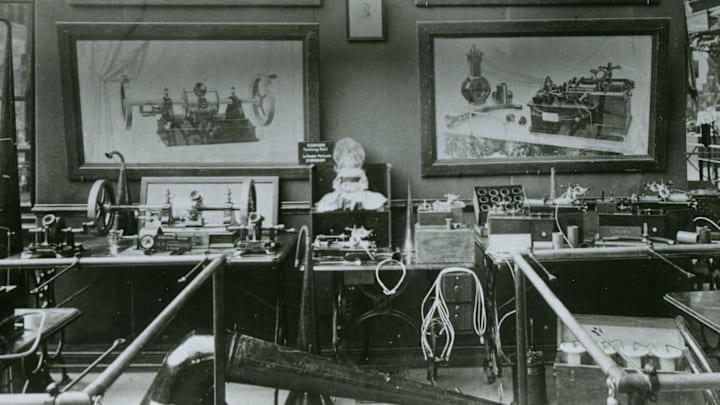In the late 1800s, Thomas Edison got into the doll business. Not long after inventing the phonograph, the prolific entrepreneur imagined a line of toys that would make various sounds, like a train that would imitate the puff of steam exhaust, dogs that could bark, and dolls that could speak. Talking dolls were already a popular toy among children of the time, but they relied upon primitive technology to imitate simple words like mama and papa. Edison’s dolls would feature actual recordings of human speech, turned on by cranking a shaft in the doll’s back.
Edison’s talking dolls recited nursery rhymes like “Jack and Jill,” “Little Jack Horner,” and “Twinkle Twinkle Little Star,” by means of a tiny cylindrical phonograph inserted into the doll’s body. At first, Edison tried making the recordings himself. As it happened, people thought a delicate doll of a young girl—rosy-cheeked and waxen-faced—sounded weird emitting the voice of a gruff adult man, so he eventually hired a team of young women, who were paid a few cents per record they made. (Arguably, these ladies were the world’s first recording artists.) The audio in the prototypes wasn’t entirely clear, so Edison and his team wanted the dolls to recite snippets of poems and rhymes people already knew.

Though he had worked on the doll concept for more than a decade, the experimental toys proved to be unpopular playthings. One Washington Post headline when the dolls debuted read “DOLLS THAT TALK. They Would Be More Entertaining if You Could Understand What They Say,” as historian Patrick Feaster writes in his excellent cultural history of the toys. (The reporter sarcastically wrote that the dolls “said with great distinctness, ‘Yah—yah—yah—yah—yah—yah—yah—yah.’”) They were also plagued by mechanical problems. “We have had five or six recently sent back, some on account of the works being loose inside, and others won't talk, and one party from Salem sent one back stating that after using it for an hour it kept growing fainter until finally it could not be understood,” one toy store proprietor wrote. And they were relatively expensive: An undressed doll cost $10 in 1890, around $267 in 2015.
Only a month after the debut launch in April 1890, Edison ceased production, having sold only 500 dolls. Many of the remaining dolls were sold sans phonograph.
In 2015, some of the fragile dolls that remained began to speak again, thanks to a new technology that can reconstruct audio from previously unplayable recordings, developed by Lawrence Berkeley National Laboratory and the Library of Congress. In April of that year, the National Park Service posted eight Edison Talking Dolls recordings created in the late 1880s on its website.
At least one of the recordings—“Little Jack Horner”—seems to come from cranking an actual doll that was brought by a man from Montclair, New Jersey, to the Edison Historic Site around 1984.
According to Edward Pershey, who was then the supervisory museum curator at the site, “It was in pristine condition, in an original box, and had the original instructions. He offered to play the doll by turning the crank on the back, and so I asked him to wait a few minutes. I ran to my office to retrieve a cassette tape recorder. (High tech!) We set up the recorder in front of the doll and he cranked away. The doll uttered the first lines of the nursery rhyme ‘Little Jack Horner.’ I am surprised and pleased to find out that that specific cassette recording may be the only example of an Edison Talking Doll recording created by actually operating the doll and not by taking the sound signal off the ring-shaped cylinder some other way.”
Dolls are already the world’s creepiest playthings, lodged deeply in the uncanny valley, that weird purgatory where things look almost human, but just off enough to unsettle. Thalia Wheatley, a professor of psychological and brain sciences at Dartmouth College, looked into why dolls evoke this reaction, and apparently it boils down to how our brains perceive faces—and whether there’s consciousness behind them. When assessing something that looks like a face, Wheatley told VICE, “You’re basically looking to see whether this person has a mind you can connect with. Is somebody home?”
Dolls are creepy because we recognize that they have faces, but we can’t find consciousness under that. “There are these signals that are telling our brain this thing is alive,” Wheatley said. “But we know it’s not alive. And that juxtaposition is really creepy.”
Now imagine a glass-eyed baby doll that emits an unintelligible, high-pitched crackling voice from a mouth that doesn’t move. That’s an Edison Talking Doll—and it’s somehow even creepier than you can imagine. (The New York Times has some great photos of them.) Thanks, modern technology, for allowing these eerie, century-old doll voices to haunt our dreams yet again.
If you want to be further creeped out, read up on these famous dolls that are said to be haunted.
A version of this story ran in 2016; it has been updated for 2024.
